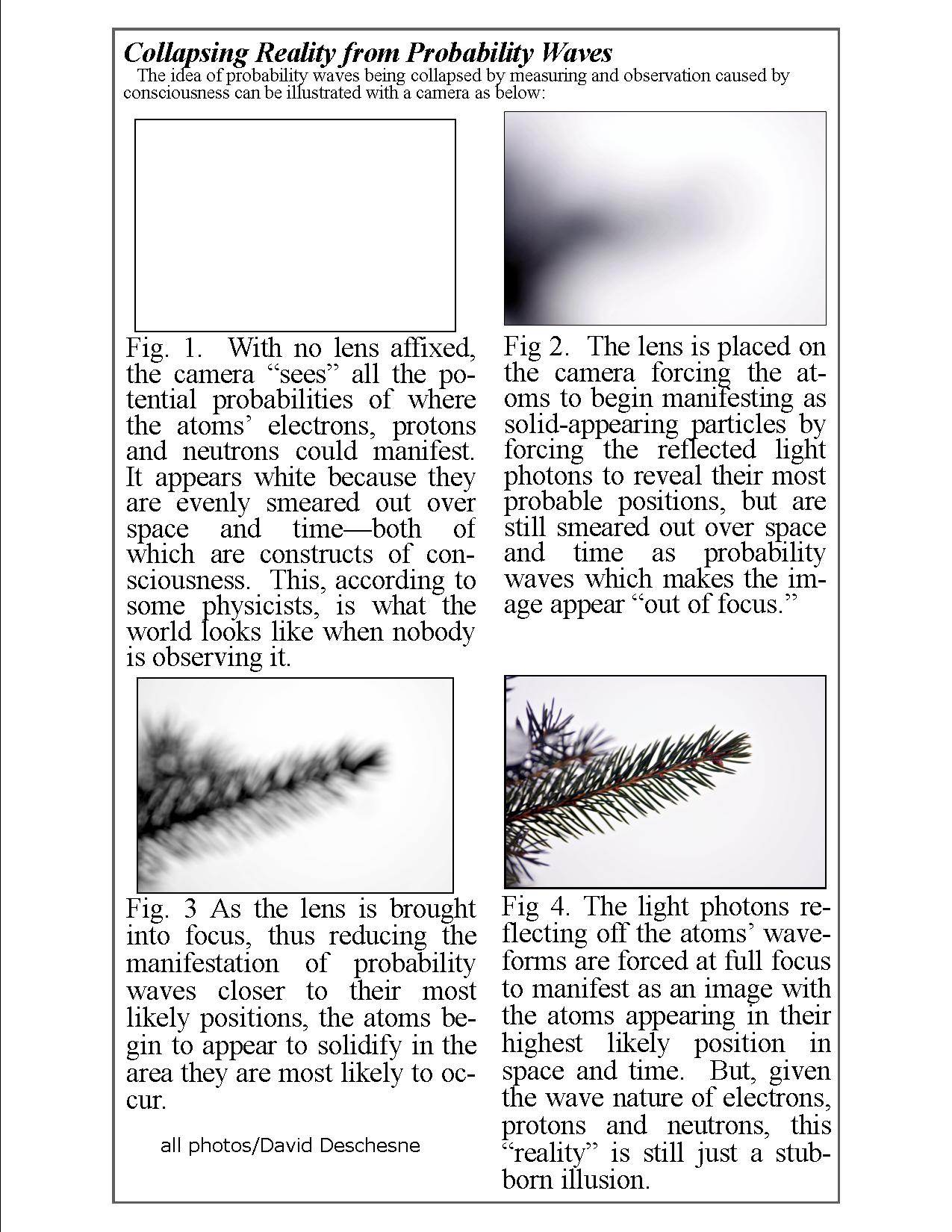Modern Miracles & the Nature of Reality

By: David Deschesne
Editor/Publisher,
Fort Fairfield Journal
January 4, 2017
(click photo below, to enlarge)
 Everyone who has even a casual experience with the Holy Bible is familiar with the stories of miraculous events. Looking back at the story of Moses and the burning bush and the miracles Moses and Aaron performed for Pharaoh (which were subsequently duplicated by Pharaoh’s magicians) are just a few examples in the Old Testament. The New Testament’s miracles center around Ieasous (later renamed “Jesus” in the 1600’s when the letter J entered the English alphabet). Jesus healed the sick, turned water into wine, fed 5,000 with a few loaves of bread and fish. These are all considered miracles because they cannot be explained using our current understanding of physics.
Everyone who has even a casual experience with the Holy Bible is familiar with the stories of miraculous events. Looking back at the story of Moses and the burning bush and the miracles Moses and Aaron performed for Pharaoh (which were subsequently duplicated by Pharaoh’s magicians) are just a few examples in the Old Testament. The New Testament’s miracles center around Ieasous (later renamed “Jesus” in the 1600’s when the letter J entered the English alphabet). Jesus healed the sick, turned water into wine, fed 5,000 with a few loaves of bread and fish. These are all considered miracles because they cannot be explained using our current understanding of physics.
While these are all old, dusty stories from a bygone age. What would you think of someone today who performed legitimate miracles just as amazing as in the Bible? Some would write those events off as “works of the devil.” But, did God stop being God and stop allowing people to perform supernatural events after the loose collection of manuscripts were assembled into what we call the “Bible” today? I think that’s both unlikely and selling God short, don’t you?
Post-Biblical history is replete with examples of miracles that defy scientific explanation. A few are recounted by Michael Talbot in his book, The Holographic Universe. For example, at the Duomo San Gennaro, the principle cathedral of Naples, a vial of dry, crusty blood from San Gennaro—beheaded in 305 A.D.—is said to liquefy twice a year. If it doesn’t liquefy, bad events usually follow. In 1902, a group of scientists performed a spectroscopic analysis of the liquid and confirmed it is blood, but the reliquary containing it is so old and fragile the church will not allow it to be cracked open for further tests.
In 1982 an English physician named Ruth Coffin had diagnosed a young Pakistani woman with severe blood loss due to a complicated pregnancy in her eighth month. The woman had at that point lost a massive amount of blood. Dr. Coggins was able to secure two pints of blood and transfuse it into the woman, but her bleeding continued unabated. Coggins then resorted to prayer. The woman, who had lost more than 12 pints of blood during an emergency Cesarean section and should have been dead, eventually recovered and went home with her baby 10 days later. Coggins was sure the woman had lost more than her body’s total blood volume during the surgery. Since the human body cannot produce new blood faster than it loses it under such drastic conditions, Coggins’ only explanation is new blood was miraculously materialized into the woman as a result of her prayer.
Talbot recounts several other modern miracles in his book. For those interested in researching further, I highly recommend it (2011 edition ISBN 978-0-06-201410-8). But, be forewarned that its explanations are apt to aggravate Bible-thumping fundamentalists who think the only legitimate miracles in the history of the world are those mentioned in the Bible.
One of the most interesting modern-day miracle workers lived in India from 1929 until his death in 2011. Many of his plethora of miraculous acts were researched and cataloged by Dr. Erlendur Haraldsson Ph. D. in his book, Modern Miracles: Sathya Sai Baba, The Story of a Modern Day Prophet.
Sathya Sai Baba was born in Puttaparthi, India. His given name was Ratnakaram Sathyanarayana Raju but he changed it in 1943 when, after receiving a scorpion bite, he felt changed and was able to manifest miraculous events. He believed in his body was the reborn spirit of Sathya Baba, an Indian mystic and wonder worker who died in 1918.
Since his transformation in 1943, Sai Baba was able to produce miracles that have yet to be explained by modern science.
One of Sai Baba’s most frequent miracles was the production of vbuti—an ash made from burnt cow dung common in Indian religious ceremonies—on demand from the palm of his outstretched hand. Dr. Haraldsson witnessed this event several times up close and said the ash seemed to materialize out of thin air a few inches away from Baba’s hand.
Sai Baba performed many miracles that parallel those of Jesus in the New Testament, though Baba—like Jesus—never said he was God, only that he received his power from God.
For example, the story of Jesus feeding the masses by materializing food out of thin air is duplicated several times by Baba in his life’s history and he was even said to materialize food in his hands on demand, based upon what the person in his presence asked for. In this respect, he could not have prepared a simple magician’s trick or sleight of hand because he never knew what the person he came in contact with was going to ask for. He just conjured up the food that was requested—usually sweet Indian treats made from honey and flour of various designs—as people requested them.
There was also a time when he and around forty traveling companions had stopped for a lunch. Their host only had a small tin of rice, enough for two people at the most. Nearly two dozen people were seated in a circle around him and he fed all of them with seconds until they were full with just those two tins of rice. Nobody entered the circle and he had no way to conceal any extra rice on him. (op cit. pp. 221-223) Those in attendance claim to believe he materialized the rice and other foodstuffs they ate from out of thin air similar to the story of Jesus feeding the masses with a few fish and a couple loaves of bread.
In addition to manifesting food on demand, he would make various fruits appear on trees they were not native to, and out of season. For example, a pear or apple could be plucked from a fig tree instantaneously, on his command.
He also is reported on two separate occasions to have changed water into gasoline.
Sai Baba was also adept at materializing solid objects on demand with a wave of his hand. Such objects were usually fine jewelry custom made out of thin air as the person requesting it asks. Other times he was said to manifest small golden statues or even freshly baked cakes by randomly plunging his hand into the sand on a beach and pulling the objects out, all in front of multiple witnesses at random, unrehearsed locations.
Sai Baba also was able to dematerialize in one location and rematerialize some distance away—in broad daylight in front of dozens of witnesses.
The book just cited by Dr. Haraldsson is well-researched and meticulously documented, where the author himself personally witnessed many of the events and recorded them. For those interested in researching the story of Sai Baba further, I highly recommend this book, too (ISBN 978-1-908733-25-2).
Michael Talbot postulates in The Holographic Universe—that the physical reality we perceive today is more a product of the mind, or perception, than it is a solid world independent of the human observer.
Quantum physics also bears this point out when examining the attributes of a simple electron. Scientists used to think electrons, protons and neutrons—the stuff that makes up our material world—were solid particles. But, scientific tests have confirmed those entities only appear to be solid depending on how you observe them. Indeed, electrons, protons and neutrons behave both as solid particles and as energy waves, simultaneously.
For example, the double slit experiment shows that when you fire electrons, one at a time, at a slit they will go through behaving as if they were solid particles, but open up a second slit and a single electron will then go through both slits simultaneously, manifested as a wave. When the observer then sets up measuring equipment to observe which slit a single electron actually goes through, it reverts to behaving like a particle again—as if it was aware it was being watched. But, perhaps the electron is derived from a sea of probability waves and it is human consciousness that collapses it into appearing like a particle existing at a point in space and time. A way I have found to illustrate this concept is with a simple camera.
If you take the lens off of a camera and expose either the film or digital capturing element, it will show a smeared out light with no recognizable objects. This, I believe, is showing us what the probability waves we are immersed in actually look like when not observed. (refer to image at beginning of article, click on it to enlarge it).
When you place a lens on the camera and it is severely out of focus, the same smearing out of the waves occurs. But, as you bring the lens “into focus” you are forcing the light photons to appear to manifest at the point in space the atoms are most likely to occur in (based upon their probability waves). As the lens is brought into tight focus, the most probable location for the electrons, atoms and photons is then forced to manifest. This is what happens when we observe the world with our five senses: an infinity of probability waves is “brought into focus” via the lens of consciousness and the waves then manifest as observable “particles” which we perceive as solid reality.
Outside of conscious observation, the entire world and universe is just a smeared out sea of probability waves, which I believe are what are being referred to in the Book of Genesis as the “mayim” translated as “waters” in English. The Book of Genesis may be describing this probability wave foundation of reality. I have already written a whole series on this and archived it on the Fort Fairfield Journal’s website.
We are just beginning to unravel the mystery of reality—a mystery our 19th and 20th century physicists thought they have solved. It now seems that reality is more a constant flux of probability waves that are collapsed into solid-appearing particles and forms by the conscious observer and that it is the observer who creates solid reality by perceiving it into existence rather than the currently held belief that solid reality came together then formed the observer and ultimately his consciousness.
This consciousness-based creation of reality theory is called Biocentrism. It essentially states that the world, and the entire universe, exists as a construct within the mind of the conscious observer and that no real, separate, tangible physical reality exists outside of the person doing the observing.
If this is truly the case, then the mechanics of miracles might be more easily understood as products of the conscious mind manipulating the sea of probability waves we are all immersed in and collapsing it into the “reality” of solid particles that we all seem to think are real and tangible.
Moses could do it, Jesus could do it, Sai Baba could do it and it is likely we all can, given the proper connection and relationship with the source of all consciousness. That source is commonly referred to today as the Supreme Consciousness; the First Source and Center; or simply, “God.”









